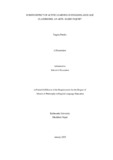
Please use this identifier to cite or link to this item:
https://hdl.handle.net/20.500.14301/538| Title: | Domino Effect of Active Learning in English Language Classrooms: An Arts-Based Inquiry. [Unpublished MPhil Disertation] |
| Authors: | Pandey, Nagma |
| Citation: | Pandey, N.(2025). Domino effect of active learning in English language classrooms: An arts-based inquiry. |
| Issue Date: | Jan-2025 |
| Publisher: | Kathmandu University School of Education |
| School: | SOED |
| Department: | DOLE |
| Level: | M.Phil. |
| Program: | Master of Philosophy (MPhil) in English Language Education |
| Abstract: | The study explores the domino effect of active learning in English language classrooms which employs Kolb’s Experiential Learning Theory (1984). Domino effect creates a situation wherein the first event causes another similar kind of event and the second event further causes another similar event and the process of creating events keeps going on impacting learners immensely either positively or negatively. The research scrutinizes the positive domino effect, i.e., good impacts which occur in a series or a chain reaction in a learner with the implementation of various active learning strategies. The research is all about how a notable transformation takes place in a learner who gets to understand things better through his/her first-hand experiences in or outside the classroom via the implementation of various active learning techniques. I have used Arts-based inquiry as the research methodology in order to generate information from my participant students. Arts-based methodology allows a researcher not only to study, retrace and reassess both the emotive and personal experiences of learners but also allows him/her further reflections on those lived experiences. It helps in questioning more rather than providing fixed answers, without hindering data generation and analysis, directing the researcher to newer avenues for exploration (Naidoo et al., 2023). This methodology accepts both linguistic and non-linguistic art forms. Thus, visual and literary arts like artifacts, interview transcripts, reflections, poems, pictures, paintings, doodles etc., are used as the data for the research. The study contributes to the exploration of the application of active learning strategies in English language classrooms for the cognitive development and competencies in a learner. As the world is demanding for a paradigm shift in academia, i.e., from the traditional teaching approach to a more promising one (Garnham et al., 2024), the study serves as a handbook for the aspiring teachers to learn how the use of active learning strategies cause a positive domino effect in pupils, simultaneously, encouraging them to apply and advocate active learning teaching methods. With the use of arts-based methodology, it proves to be an experimentation on how multiple art forms can be used to generate, thematize and analyze data. The study is a beacon for newbies who want to be an artist-researcher like me. Moreover, it works as a strong documentation on how the implementation of active learning techniques can bring transformation in learners by ensuring in them the acquisition of literacy skills and life skills. |
| URI: | https://hdl.handle.net/20.500.14301/538 |
| Appears in Collections: | Dissertation |
Files in This Item:
| File | Description | Size | Format | |
|---|---|---|---|---|
| Nagma Pandey Final Dissertation (1).pdf | 7.48 MB | Adobe PDF |  View/Open |
Items in DSpace are protected by copyright, with all rights reserved, unless otherwise indicated.